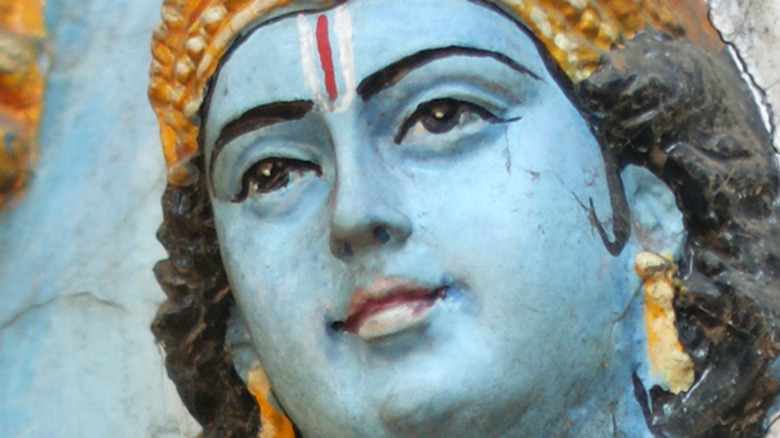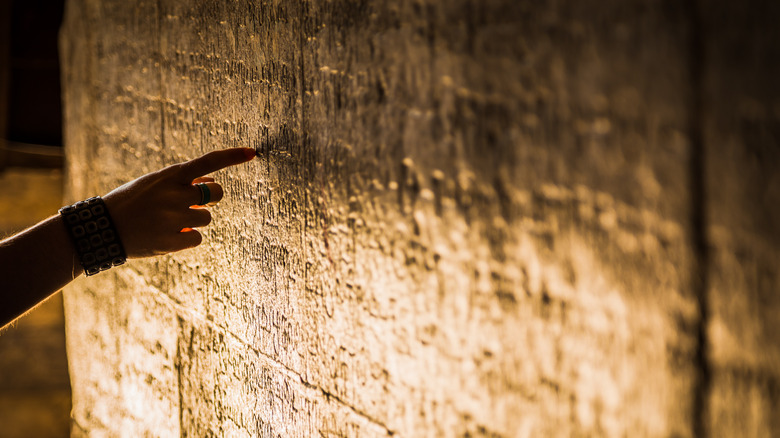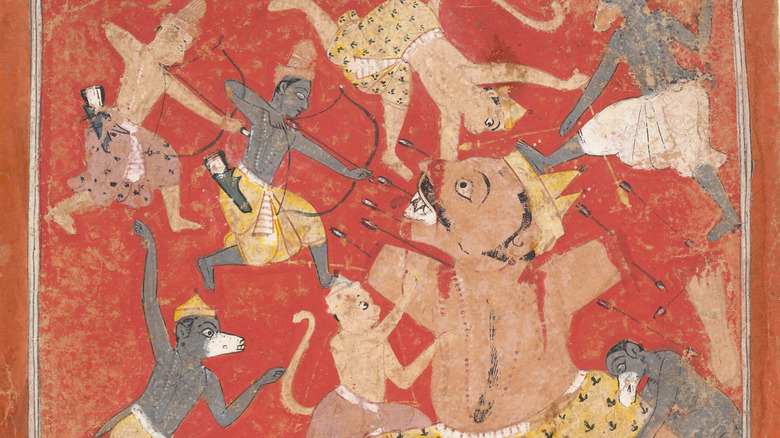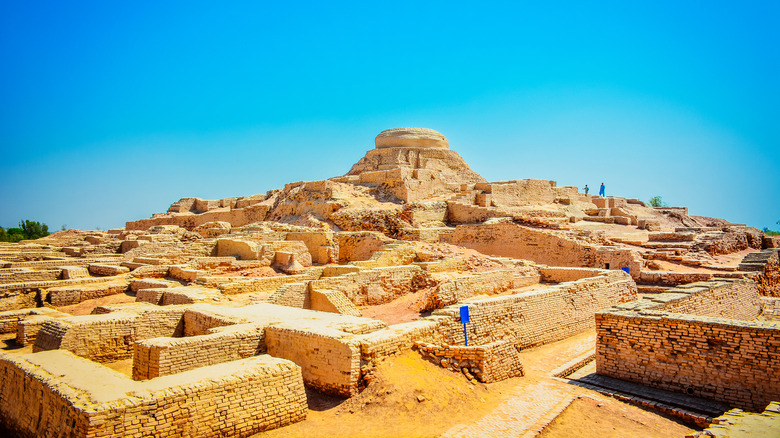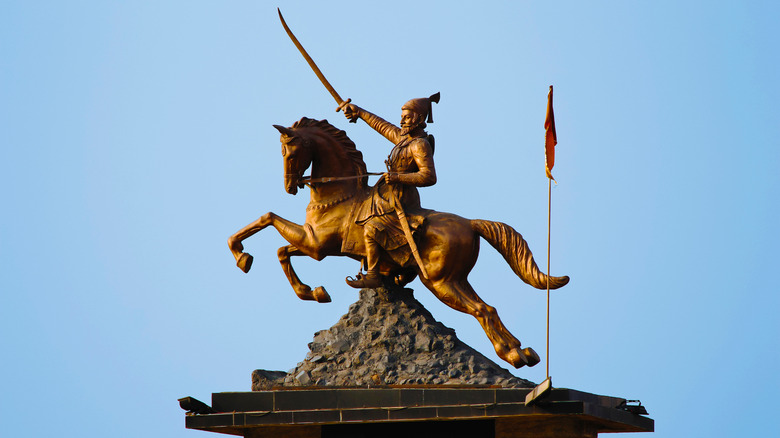How The Vedas And The Mahabharata Influence Modern Weapons
India is home to a rich body of religious, philosophical, and epic poetry. The oldest of these is the collection called the "Vedas," including the "Rig Veda," which may be as much as 3,500 years old, per Britannica. These verses are written in an archaic language, Sanskrit, a distant cousin of Latin and Greek. They praise a pantheon of Indian gods and describe religious ceremonies and metaphysical concepts. India's priestly caste, the Brahmins, have memorized and chanted these poems since the dawn of Indian civilization.
About 1,000 years after the Vedas were first written, epic poetry found its way into Sanskrit writing, carefully copied onto palm-frond manuscripts. These are the cousins of Homer's "Iliad" and "Odyssey," and tell similar stories of great battles and heroes, as well as the poignance and impotence of human will in the face of an unknowable providence. The most familiar of these is the "Bhaghavad Gita," or "Song of God," once as popular among New Age Westerners as yoga and patchouli. It is the sixth book of a much longer epic, the "Mahabharata." The "Gita" tells the story of a prince named Arjuna who has taken the field to battle his own cousins. Despairing at the thought of killing his relatives, he consults his charioteer, who is the god Krishna in disguise (above). Krishna urges Arjuna to fulfill his "dharma," or sacred duty. Off they gallop, into the spears of the enemy.
Weapons of war
"Mahabharata," the "Ramayana," the "Vedas," and other ancient Sanskrit texts have retained their importance among the world's 1 billion Hindus, a full 15% of humanity (via Pew Research Center). Like the Bible, these documents are the spiritual biography of a people. They trace their relationship with the divine, record their earliest memories, and elaborate the web of rights and obligations that bind people and families to each other.
These texts have other, less obvious legacies as well. As Avinash Kumar writes in Business Insider India, "Mahabharata" and the "Vedas" predicted the weapons of modern warfare. This seems absurd at first — surely even the most primitive armies in the 21st century don't throw spears and shoot arrows at the enemy (although horses still find use in rugged countries like Afghanistan, whose mountain trails are impassable to jeeps, per the Military Times). What weapons is Kumar talking about?
The Astra
The first weapon Kumar mentions is the astra, which he translates as "missile." The term is vague; Sanskriti Magazine, for example, defines astras as "celestial weapons," controlled by a specific deity who must be invoked by the repetition of a specific, incantatory formula. The Times of India describes a number of these supernatural weapons, including the Aindra Astra, whose reigning deity was the sky god Indra, and which, if properly invoked, unleashed a shower of arrows from the sky. In the "Ramayana," the character Indrajit invokes the gods known as the Nagas to summon the Naga Paasha, which causes its target to be engulfed in the coils of various venomous snakes.
Kumar speculates that astras may have used or metaphorically explained gamma rays, or some other high-tech weaponry. He notes that astras can sometimes be retrieved by their invoker, much like the reusable missiles, a technology currently in development (via MIT Technology Review).
An ancient atom bomb?
Kumar's claims are nothing if not imaginative. Discussing the possible significance of the astras, he speculates that one of them may have been a kind of nuclear weapon. His reason? The central war of "Mahabharata" is said to have killed over 1.5 billion people in 18 days, according to its 11th book, chapter 26 (via Sacred Texts). Such destruction, Kumar reasons, suggests a nuclear attack.
Kumar also cites the ancient, ruined city of Mohenjo Daro (shown above), located in modern Pakistan: "The wide degree of devastation found at the site of Mohanjo Daro corresponds exactly to Nagasaki." This is debatable; according to another post at Britannica, Mohenjo Daro was likely destroyed by multiple factors, including flooding in the Indus River Valley. However, as journalist Jason Colavito explains on his website, rumors have circulated for decades about radioactive human skeletons being dug up in Mohenjo Daro, allegedly the victims of a nuclear explosion. Ultimately, Colavito says, this was untrue; Soviet publications pushed this story in the Hindu press in the 1960s, he alleges, to stir up nationalist sentiments that might push non-aligned India away from the West and closer to the USSR.
Last use of Indian epic weapons
Although Kumar compares the supernatural weapons of the Indian epics to advanced contemporary arms, he doesn't discuss the more banal weapons that the heroes carried into battle: swords, chariots, bows. How long were these in use?
The chariot may be the most archaic of these. We often associate them with the Greeks and Romans, but Britannica explains that they are about as old as the Vedas, first appearing in Mesopotamia. Initially pulled by asses or even oxen and unfit for combat, the appearance of the war horse transformed the chariot into a weapon in its own right. It spread across Asia and Europe, and remained in use among the remoter Celtic tribes until the 400s A.D. However ancient the chariot may seem, it has its contemporary correspondents. As a way to move troops, it's quite a bit like a modern personnel carriers; in battle, it may have functioned tactically like a tank.
Swords lost their importance as weapons in the 20th century, with the decline of cavalry. But improvised swords, usually machetes, have appeared on battlefields across Africa and Latin America. As recently as 2022, militias in Congo have used them to deadly effect (via Defense Post). The bow, on the other hand, has just about disappeared. But the last time one appeared in a pitched battle was fairly recently: one "Mad Jack" Churchill carried a longbow into battle in 1940, shooting at least one German solider with it (per Historic UK).
